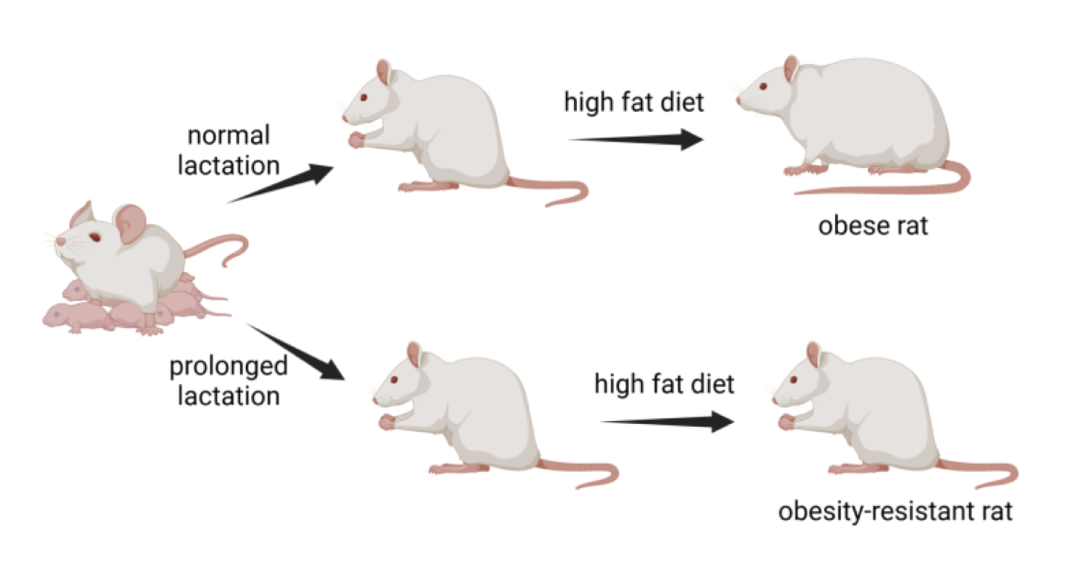Dr Vincent Prevot and Professors Markus Schwaninger and Ruben Nogueiras explain the significance of the perinatal maternal lifestyle, specifically prolonged lactation, in shielding offspring from chronic disease
In recent years, the escalating prevalence of obesity and its associated diseases has prompted numerous studies covering broad aspects of metabolism, from the genetic inheritance of disorders to the early emergence of non-genetic metabolic traits. Pregnancy and lactation are now identified as the pivotal periods for establishing these traits, which can develop from infancy into adulthood. Therefore, maternal influences are crucial in the development of pathologies arising from a combination of genetic and non-genetic factors, as well as lifestyle.
Studies on rodents and humans have highlighted the significance of the perinatal maternal lifestyle in programming peripheral metabolic tissues and determining the risk of metabolic diseases in offspring. Research on the impact of maternal lifestyle on the hypothalamus of the brain, a central organ in regulating feeding and energy, has predominantly concentrated on the effects of poor maternal nutrition.
HFD-induced obesity
One of our recent studies in rats has demonstrated that prolonging the duration of lactation can shield offspring from obesity when they are subsequently exposed to a high-fat diet (HFD). HFD-induced obesity in rodents is a widely used model because they exhibit many of the same physiological and metabolic changes seen in human obesity. These include significant weight gain, increased body fat, insulin resistance, glucose intolerance, and alterations in lipid metabolism.
The mechanism by which prolonged lactation protects against obesity involves a peripheral tissue–central nervous system signaling crosstalk in the offspring. This crosstalk plays a key role in the regulation of energy balance and involves a complex interplay between the hypothalamus and peripheral organs. The hypothalamus, which is located just below the thalamus and above the pituitary gland, is a central hub for integrating various physiological signals and orchestrating appropriate responses to maintain the body’s equilibrium. These signals include leptin from adipose tissue, insulin from the pancreas, and ghrelin from the stomach to regulate hunger, satiety, and energy expenditure. Neuronal pathways in the hypothalamus respond to these signals to modulate appetite and metabolic processes. Additionally, the hypothalamus communicates with peripheral organs via the sympathetic nervous system to regulate multiple actions.

FGF21 production
The beneficial effects of prolonged suckling are initially mediated by an increase in liver fibroblast growth factor 21 (FGF21) production. FGF21 is a hormone primarily synthesized by the liver that acts on various tissues to enhance insulin sensitivity, improve glucose uptake, and promote fatty acid oxidation, thereby contributing to the maintenance of metabolic homeostasis. Additionally, FGF21 stimulates energy expenditure and induces thermogenesis. Its influence extends to appetite regulation and stress response, making it an integral part of the body’s adaptive mechanisms. FGF21 exerts some of these effects by its actions in the central nervous system, including different hypothalamic neuronal subpopulations.
In this study, we found that FGF21 is shuttled into the hypothalamus by tanycytes, a specialized glial cell type lining the wall of the third ventricle in the median eminence of the hypothalamus. Tanycytes form a bridge between the blood and the brain, preventing the free diffusion of molecules from the blood into the brain and allowing certain blood-borne signals to access their target neurons. When FGF21 reaches the brain, it acts in neurons of the lateral hypothalamic area and zona incerta, which express the receptor for FGF21. These hypothalamic areas are known to interact with each other and with other brain regions to coordinate a wide range of physiological and behavioral processes. For instance, both regions are integral to the brain’s ability to maintain homeostasis, regulate behaviors related to survival (such as feeding and arousal), and integrate sensory and motor functions.
When reaching these neurons, FGF21 decreases body weight and increases brown adipose tissue thermogenesis. This mechanism is crucial for thermoregulation and has the added benefit of increasing overall energy expenditure, thereby contributing to the reduction of weight gain.
This process is driven by the presence of uncoupling protein 1 (UCP1) in the mitochondria of brown adipocytes, which uncouples oxidative phosphorylation from ATP production, dissipating energy as heat.

This work is licensed under Creative Commons Attribution-NonCommercial-NoDerivatives 4.0 International.


